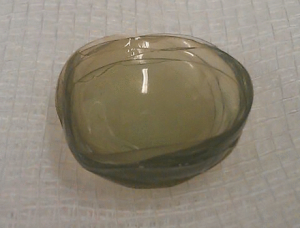
A woman scheduled for cataract surgery in Birmingham, England was found to have 27 soft lenses in her eye. A group of 17 had formed into a single mass shown in the picture, and an additional ten lenses were also located during an extended examination.
Pretty amazing.
What is truly remarkable is that the patient never complained about discomfort or vision loss, and had worn disposable lenses for 35 years. When she tried to remove a lens and could not find it, she assumed she dropped it and simply put in a new lens.
The eye reacts to ‘foreign’ bodies left in place for long periods; mucus sealed off the lenses from the rest of the eye and they bonded together into a single mass.
 Dr. Casey Claypool, OD who works at Empire Eye Physicians in eastern Washington said it would be very unlikely for KC patients to accumulate multiple lenses on their eyes without knowing it. Rather than having a lens shift, KC patients are more used to having their contact lenses pop out because of the less than ideal fit in many circumstances.
Dr. Casey Claypool, OD who works at Empire Eye Physicians in eastern Washington said it would be very unlikely for KC patients to accumulate multiple lenses on their eyes without knowing it. Rather than having a lens shift, KC patients are more used to having their contact lenses pop out because of the less than ideal fit in many circumstances.
How can you tell if you’ve lost a lens under your eyelid?
Dr. Claypool offers an easy trick to find a dislocated lens. Lift and fold the upper lid back on itself. Any lost lens should be visible and easy to retrieve. If you are still unsure and feel like there is something there, ask a friend to shine a flashlight on the inside of the upper eyelid. The contact lens will reflect the light and will be easy to spot. He reassures his patients that lenses do not go further than the upper eyelid. “A lot of new contact lens wearers express concern that their contacts will travel around their eye and end up in their brain. Part of our job is to educate patients about what is likely and not likely to happen.”
He stresses to his patients the importance of finding a clean and comfortable setting to insert and remove contact lenses, and to never rush the process.
Among the patients in Dr. Claypool’s practice are farmers, truckers, and other workers who spend considerable time out-of-doors. Their biggest complaint is that the environment – grit, dust, and pollen – can make wearing contact lenses unbearable.
For that reason, he is a big fan of scleral lenses and fits them on many of his KC patients. In most cases, the vision results are good, the fit is more comfortable and problems with dirt and dust are minimized.
He also educates his patients about dry eye disease. There are new in-office treatments and prescription eye drops available that can extend the number of hours that a person wears contact lenses each day without suffering irritation or redness. Dr. Claypool advised patients to talk to their eye doctors about treatment options that may offer relief from dry eye symptoms.
Another essential part of his job is to remind his contact lens patients about the importance of eyecare hygiene. Leaving your lenses in overnight, wearing them while swimming, topping off solution, or even popping a lens in your mouth for a ‘quick clean’ when it drops seem harmless, but these behaviors can result in devastating consequences. When patients cut corners on cleaning or refilling solutions, bad things occur.
“With my KC patients, I stress that there is no fall back for them,” Claypool cautions. “Unlike most patients, if they get an eye infection, they can’t switch to glasses for several weeks or months while the infection resolves. An eye infection can be overwhelming in terms of keratoconus patients and their ability to function.” Claypool reminds his KC patients to be extra vigilant and contact lens hygiene.
No one should end up with 27 contact lenses in their eye. And no keratoconus patient should become lax about their eyecare.
 Dr. Casey Claypool, OD practices at Empire Eye Physicians in Spokane, WA.
Dr. Casey Claypool, OD practices at Empire Eye Physicians in Spokane, WA.

